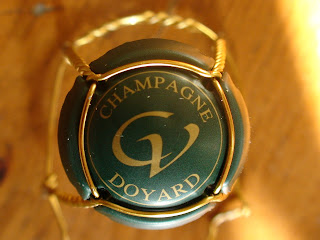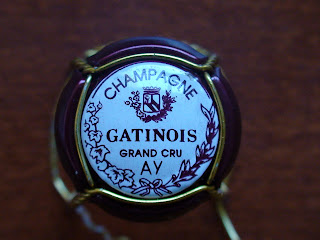I asked Peter Liem where Domaine de L'Arlot stands in the pantheon of Burgundy and he said "People who really know and love Burgundy love Domaine de L'Arlot." He didn't mean that you must be a vastly experienced Burgundy lover in order to appreciate them. They're lovely wines and anyone would enjoy them. I think he meant that the wines are often overlooked amidst the many huge names in Burgundy, but are never overlooked by those who have extensive experience, the cognoscenti, if you will.
 Southern wing of the Domaine, where we stayed.
Southern wing of the Domaine, where we stayed.
Although Domaine de L'Arlot owns vines in Romanée St. Vivant, the exalted Grand Cru, and also in 1er Cru Les Suchots in Vosne-Romanée, it is probably best known for wines from two relatively large 1er Cru vineyards, both monopoles of the Domaine, both located near the southern end of the vineyards of Nuits St. Georges. The vineyard Clos de L'Arlot borders Mugnier's Clos de la Mar
échale to the south, and is known for red fruited wines of elegance and finesse. The Domaine also makes a 1er Cru white wine from this site, a rarity in the Côte de Nuits. Wines from Clos des Fôrets bear some of the muscular and savage character of its more famous neighbor to the north, Les Saint-Georges.
 From the living room window, the Clos de L'Arlot under gray skies.
From the living room window, the Clos de L'Arlot under gray skies.Vineyard and winery work is rather old school at Domaine de L'Arlot, which is a good thing. Vineyards are plowed and harvested by hand, and whole clusters are used in fermentation. Since 2003 Domaine de L'Arlot has been practicing biodynamic throughout the entire estate. As you might expect, these are wines of freshness and purity, with an elegant lightness of color that belies the depth and complexity within. I could share more background information, but I would basically be quoting from these two fantastic online sources:
Bill Nanson's piece from Burgundy Report in August of 2005 does a great job of detailing the history of the Domaine and also vividly portrays the unique vineyard that bears the name of the Domaine, the Clos de L'Arlot.
Peter Liem's piece also provides great contextual information, and describes the recent tasting he attended in which he sampled wines dating back to the creation of the Domaine in 1987.
Peter Liem worked harvest at Domaine de L'Arlot in 1998 and has remained friendly with the staff ever since. It is because of this friendship that Peter stays at the Domaine when he visits Burgundy, and it is because of this friendship that Olivier Leriche extended to me the generous offer of staying there as well. Domaine de L'Arlot is in Prémeaux-Prissey, a village I have never heard of until just now. All the while I thought we were staying in Nuits St. Georges. To my foreigner's eyes, the villages in France can really blend into one another...
So, in early December I stayed at Domaine de L'Arlot while visiting Burgundy. My accommodations were pretty sick - a large and beautiful room with an attached bathroom that is larger than my bedroom in Brooklyn. I'm talking two sinks, a heater, several windows, a bidet, all class and grace. And of course, no toilet. The toilet is in the water closet in private hallway outside of the bedroom.
 Bathroom alone: $1.25 Million in New York City.
Bathroom alone: $1.25 Million in New York City.
We tasted the 2007's in barrel, many of the 2005's and 2006's in bottle. Here are some notes from our tasting:
2007 Nuits St. Georges 1er Cru Clos de L'Arlot - tastes nothing like any other NSG wine I've had. All silky red fruit and flowers, gentle, good acidity, lots of finesse. Very pretty.
2007 Nuits St. Georges 1er Cru Clos des Fôrets Saint Georges - meaty animal wildness, dark fruit, big tannic presence, rich fruit, juicy and dense. Should be brawny and beautiful in maybe 8 years.
2007 Grand Cru Romanée St. Vivant - nose of dark spices, maybe cloves, a bit animale. Intense dark fruit in the mouth, firm tannins, but the overall effect is suave and gentle. This wine is still quite closed, but there is evident depth and complexity here hiding in the shadows.
2006 Nuits St. Georges 1er Cru Clos de L'Arlot - meaty sauvage character on the nose this time, with floral dark fruit. Light and elegant in the mouth, but powerful, tannins are silky. Unusual for Clos de L'Arlot maybe, but a beauty.
2005 Nuits St. Georges 1er Cru Clos de L'Arlot - vibrant red fruit on the nose with savory brown sugar notes. Ripe fruit on the palate, ripe, ripe, ripe, but good acidity keeps it in check. Nice length, strong tannins, this wine has class. I'd love to taste it again in 15 years.
2005 Vosne-Romanée 1er Cru Les Suchots - gorgeous nose, elegant floral perfume with deep red fruit and earth tones. Tight in the mouth but generous fruit, a great mix of pwer and finesse. This is a real beauty.
2006 Nuits St. Georges 1er Cru Clos de L'Arlot Blanc - delicate layers of white flowers at the core, tangy citrus and minerals. Just lovely. Some pear in there too. Very precise and cut with firm tannins and a zesty bright finish. Very impressive indeed.
After our tasting and a brief rest, we enjoyed a delicious dinner prepared by wine maker Olivier Leriche's wife Florence, and attended by none other than Jean-Pierre de Smet, the original wine maker at L'Arlot.
 Olivier Leriche and his lovely wife Florence in their kitchen. That's Tista in the background.
Olivier Leriche and his lovely wife Florence in their kitchen. That's Tista in the background.Dinner was a beautiful fillet of beef roasted in the kitchen fireplace and served essentially raw. There was also a nice green salad, pur
ée of winter squash, roast potatoes, and a lovely fruit tart. It was the end of a long day that included a huge lunch and a lot of wine. This did not exactly enhance my ability to speak and comprehend the French language, but I enjoyed trying to decipher the various conversations nonetheless. We drank some pretty good wines at the dinner, by the way.
 Fallen heroes - they shall not be forgotten.
Fallen heroes - they shall not be forgotten.
Thank you again, Oliver and Florence, for your generous hospitality, and for an experience that I will never forget.

































